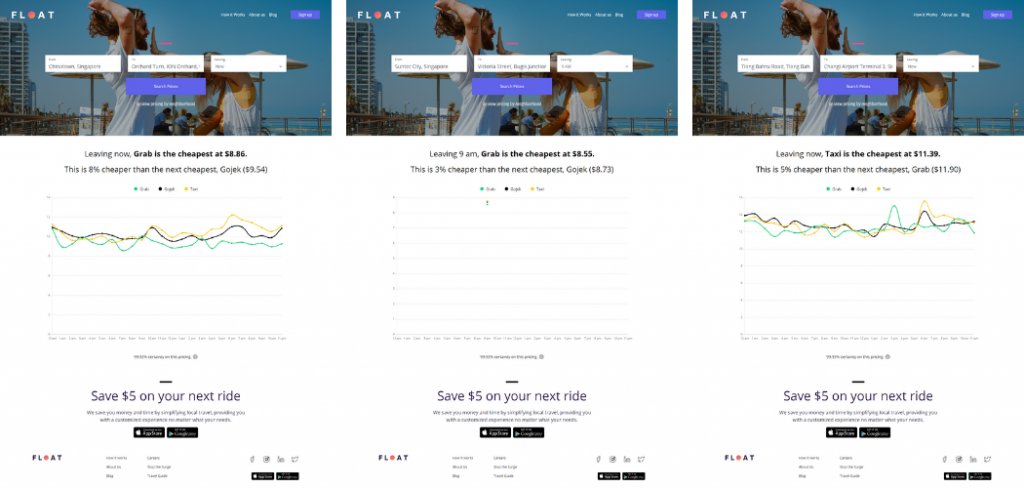In the 11 weeks that have passed since Singapore started to ease its lockdown measures, prices for certain services have been growing constantly. Private local transportation is one of them. As more and more people are moving around the city, rideshare and taxi providers are taking notice (and advantage) of the growing demand.
Singapore’s economy fell nearly 43 percent in the second quarter of 2020, compared to the first three months of the year, according to the state’s Ministry of Trade and Industry, due to the coronavirus lockdown. As restrictions are lifted, prices for services (like rideshare) and products (like some groceries) have been going up. The trend applies in other parts of the world as well. A quick analysis based on Float data collected over the last three months shows that the average ride cost for a trip inside Singapore’s main core area—Marina Bay—increased by more than 19 percent from June (when phase one of the reopening started) to the first week of August. It’s important to mention that Float data refers to prices for Grab, GOJEK and ComfortDelGro rides. The increase was lower in outer districts like Far North—13 percent for the same period.
Costs are expected to rise further as mobility and transportation services are still not operating at full capacity. Use of public transit in Singapore is still down 34 percent compared to January, according to Apple Mobility Trends Reports, while driving is still 13 percent under the level recorded at the beginning of 2020. So, how can you travel cheaper in Singapore and make sure you spend less as you go from A to B? Easy.
Use Float’s new pricing tool that will help you make the best choice when it comes to your next rideshare experience in the city. Based on actual data, with several filters available to narrow down your search, Stop the Surge is our promise for cheaper, smarter, more efficient transportation. All you need to do is insert your destination and see what would all three ride options—Grab, GOJEK and ComfortDelGro—charge you for your trip.
You can also use the form in the app to fill in your pick-up location along with the destination, and also select the time for your departure for an even more precise estimation. If you’ve used Float before or if you’ll allow it to use your location, the details for the pick-up point section will load automatically. Once you hit ‘Search Prices,’ you will receive pricing info for Grab, GOJEK and taxi for the requested trip, helping you choose the lowest fare (see image below for some examples on how it works).

The pricing info is based on rideshare data from all our users in Singapore and is up to 90 percent accurate. For an overview, choose the ‘view pricing by neighborhood’ option in the same screen and see rideshare fares from different providers for various areas in Singapore.
Why did we come up with Stop the Surge? Because rideshare is one of the few services with an unpredictable and highly volatile pricing policy, which can turn out to be quite tricky, even for today’s user who is accustomed to the rapidly changing world. We always think about ways to make the most of our data and analytics capabilities, so we launched the first version of our Stop the Surge tool, available for free, as a service of Float in Singapore. The goal is to offer people transparency on rideshare pricing.
“This is just version one for us and we’re going to continue to build out different filters, which could be related to the weather and time of year—for example, the Chinese New Year. We’ll also add in alerts, through notifications or emails, when pricing is surging in an area,” said Float Founder & CEO Stew Langille.
Users can customize notifications and alerts depending on their travel patterns and preferences. By using the app regularly and by sharing transportation data, you will benefit from faster, better customized services from Float.
Stop the Surge was first available for our users in Singapore, but other cities will follow as we develop the feature and continue to build the app. The future of transportation is based on sustainability and data as we move toward increased transparency, efficiency and smarter mobility. Our users’ experiences will help us grow and continue to offer professional and easy to use tools. These tools will lead to better trips and will save our users time and money when it comes to daily commutes or when simply getting around in the city.
Download the Float app, sign up and discover the mindful way to travel. For this, you need to understand what you are spending and where. Float will help you shrink your transportation budget, offer exclusive tips and offers based on your needs and preferences, and get you started on living a better life.




Pingback: Top Cities for the Future of Mobility – Float Blog